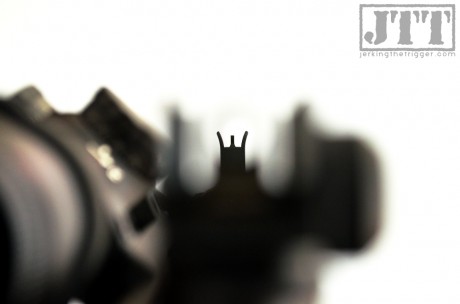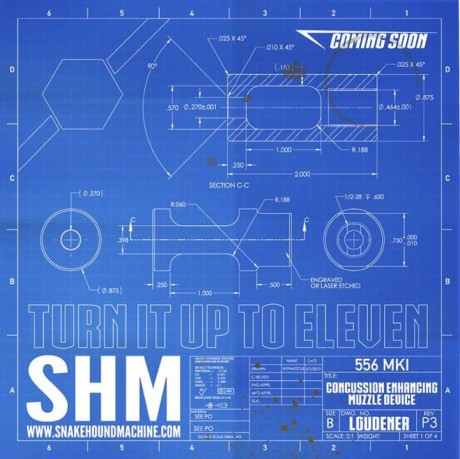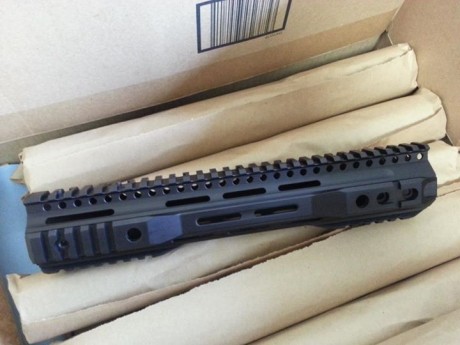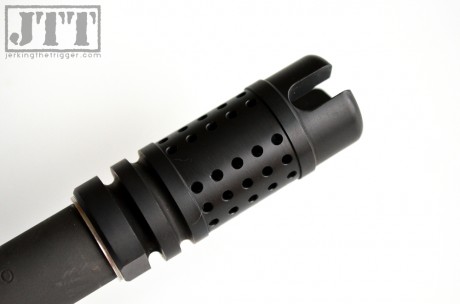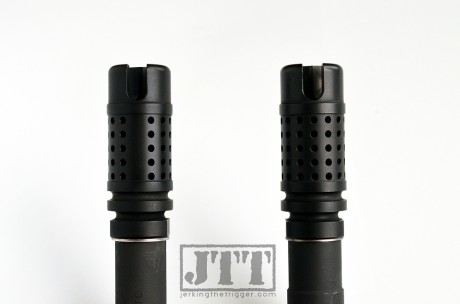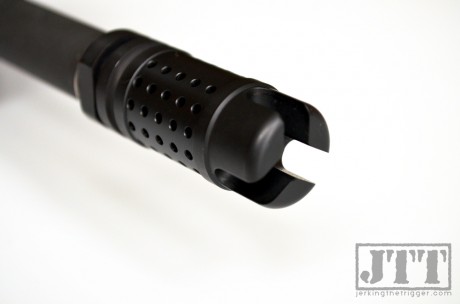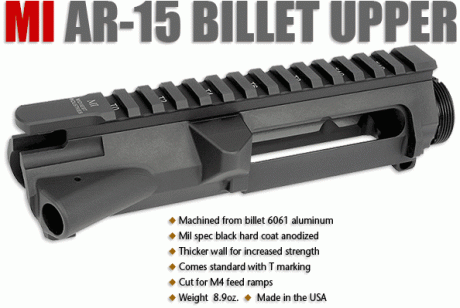There was a time when I cast a pretty skeptical eye on offset iron sights. They are easy to write off as “gamer” gear. Through research and then actual time spent behind offset sights, my view of them began to soften. I regarded them as a useful tool when used on a rifle with a high magnification optic. Now, with more time and more research, I have to admit that I am starting to believe that they are viable on a carbine with ANY type of optic.
Offset iron sights, like the Dueck Defense Rapid Transition Sights that are the subject of this review, are exceedingly useful (nearly indispensable actually) in some situations and yet many shooters still write them off because they are not a complete replacement for traditional backup iron sights. This is the strange dichotomy that offset iron sights represent and I will attempt to hash out some of the issues in this review.
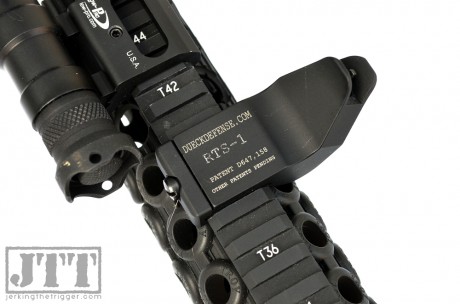
Overview
Imagine a set of fixed backup iron sights. Now imagine that those sights are turned about 45 degrees on the axis of the bore. That is the Dueck Defense Rapid Transition Sights (RTS) in a nutshell. It is important to note that the RTSs are turned 45 degrees on the axis of the bore, not 45 degrees to the rail. This is key.
The RTSs are machined from 7075 aluminum and hard anodized black for durability. They sit at the same height above the bore as standard AR-15 iron sights. The RTSs have full A2 style rear sight windage adjustment and BDC drum. The front sight elevation adjustment is also identical to the A2 iron sights. The section over the rail is designed to be extremely low profile and the RTSs mount to the rail via slotted screws (easily field improvised). The screws come with thread lock compound already applied which always makes my day.
The fit and finish is excellent. They certainly seem to be just as bomb proof as you would expect solid fixed sights to be.
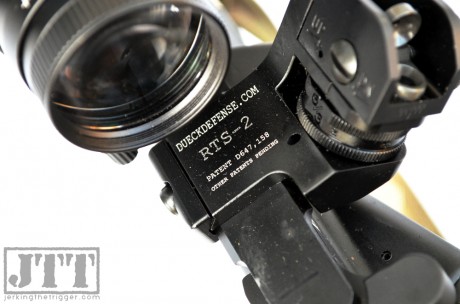
Observations from Use
First, I should probably clear up a common misconception. The Dueck Defense RTSs do not introduce any additional variables to aiming or zeroing. They can be aimed and zeroed exactly as you would any other sights. They are offset 45 degrees on the axis of the bore, not 45 degrees to the rail. That means there are no crazy windage anomalies. They work exactly like the iron sights you already know and love.
The Dueck Defense RTSs, like any new gear, will have a bit of a learning curve. They are not difficult to use at all but a little bit of practice can really hone your technique. They do require a bit of technique to be used to their full potential. Moving them into position is as easy as rolling the carbine slightly. You do not have to break your cheek or shoulder weld. The movement happens in a flash.
I find that I can acquire a sight picture most quickly by immediately switching my focus to the front sight as soon as I come off my optic. I find the front sight and bring the rear sight to it. This is key because depending on a number of factors, like familiarity level and stock shape, the sights may not roll in front of your eye in an already aligned position.
Finding the front sight first and moving the rear sight to it also allows me to use alternate sight picture when speed is paramount or in low light. I appreciate that the RTSs perform exactly like standard AR-15 sights in this regard. All of my iron sight training and techniques transfer 1 to 1.
I was interested to find out if the shape of the cheek weld portion of a stock had any bearing on using these sights. It does not. Even with wide stocks like the B5 Systems Enhanced SOPMOD or the Magpul ACS, I was able to roll the carbine over and acquire the sights without drama.
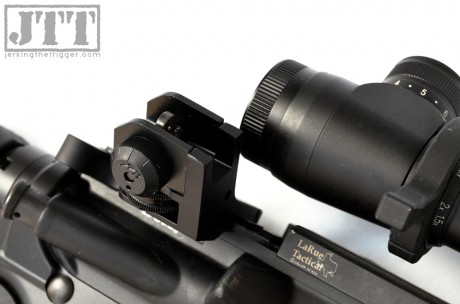
It is important to note that these are fixed sights. They do not fold. The RTSs are designed primarily to offer a faster, non-magnified sighting option for near targets and they work as they should because they are fixed sights (as they should be). It seems to me that much of the utility of offset sights is lost if you have to spend time deploying them. I want to be able to roll the carbine over slightly and find them waiting for me.
I really like how low the RTSs sit on the rails. There is basically nothing to them where they cross the tops of the rail so they should fit under just about any optic and just about any mount.
If you are using a “cat tail” on your optic, check that it doesn’t obscure the sights. I have a LaRue cat tail on my Leupold MK4 MR/T 1.5-5X optic and the end of the cat tail comes dangerously close to obscuring the view of the front sight through the rear sight when the optic is at full magnification. This is just something that you need to test on your specific configuration.
I like the build quality of the RTSs very much. I just wish the form factor was a bit different or at least another form factor was offered. I really don’t need the elevation drum but its presence isn’t that big of a deal because its removal wouldn’t really change the shape of the sights. However, I do wish the windage adjustment knob was of a more low profile design. It would also be nice to see a same plane aperture as the standard option since I believe it is a much better alternative to the standard A2 aperture. Still, I understand why the A2 format was chosen since it is the current sight format with which many users will already be familiar.
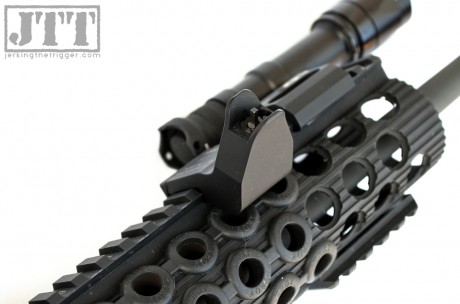
My acceptance of offset sights like the RTSs has increased over time in large part because I have seen what happens to optics when moving between temperature extremes (going from a cold day outside to a warm house) and in extreme weather like driving rain. Even high quality optics can become occluded with heavy rain or condensation to the point they are difficult to use efficiently. In these cases, a set of offset irons can eliminate down time. This is why I have been impressed by their utility even on red dot sight equipped carbines. Thankfully, I came across a post from Kyle Defoor that seems to indicate that I am not crazy (or at least not alone).
The Conundrum
As I said earlier, my impressions of offset sights in general have been fluid over time. I have gone from thinking they are just for gamers, to thinking to they are just for use with magnified optics, to wondering why they aren’t used more widely with all types of optics including red dot sights. However, as I also alluded to above, many shooters still wonder where they fit in the toolbox – not because they don’t work but because they still don’t seem like a direct replacement for traditional backup iron sights.
In my time using the Dueck Defense RTSs, I was thrilled to find that, like traditional iron sights, the person behind the sights was the only limiting factor in their performance. You roll the rifle over, align the sights, squeeze the trigger, and get the hit (assuming you did the aligning and squeezing well). So, in this sense, they could serve as backup iron sights but true backup iron sights are meant to stand in if the main optic goes down. If my main optic goes down, the backup irons become the primary sighting system and I would greatly prefer to have them in the traditional position.
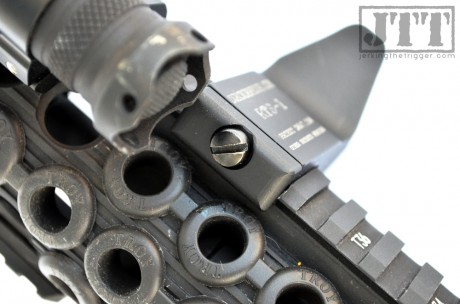
So, for me at least, it helps to think of offset iron sights as supplemental sights – not backup sights – because offset sights aren’t ideal as a standalone aiming system but they are efficient when used in parallel with another sighting system. They are not a direct replacement for backup sights but they can serve as back up iron sights well enough that I probably wouldn’t go so far as to mount both offsets and traditional backup iron sights on the same carbine. It is up to the user to decide if the tradeoff of additional speed and redundant emergency sighting is worth the potential need to use your rifle at a less than optimal angle if your main optic goes down.
The confusion seems to stem from people referring to offset sights as back up iron sights. Dueck Defense never refers to the RTSs as backup irons. So, much of this conundrum is probably due to people misunderstanding the purpose of the sights or people wanting use the sights in way that they are capable of but not necessarily intended for.
With all that said, I should point out that offset sights do have one large advantage over true backup iron sights in that they will work even if the non-functioning optic is still in place. Optics can be difficult or impossible to remove in the field depending on the mounting solution so the ability to have an redundant sighting system that can be used even with the non-functioning primary optic still in place is an attractive benefit.
Clear as mud?
Wrap Up
The Dueck Defense Rapid Transition Sights work as advertised. They offer a fast, easy to use alternate/supplementary sighting option to be used in conjunction with magnified optics. However, they also offer a viable redundant sighting system for use with any optic, including red dot sights, in situations where the environmental conditions change rapidly and drastically or in the case of a failure of the optic. They are not true backup sights but they can be used as such. If you have a proper understanding of their intended purpose, sufficient training, and an actual need for them, you will love these sights.
Check out the Dueck Defense Rapid Transition Sights at DueckDefense.com.
